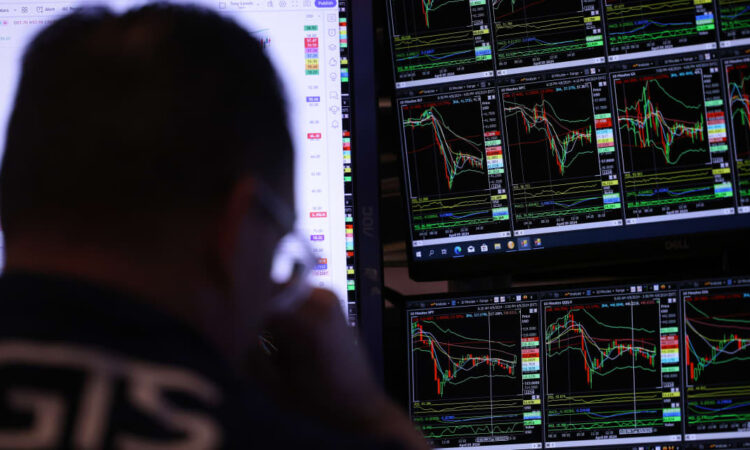
Rising Treasury yields have the potential to trigger a stock market sell-off, but the upcoming earnings season and the fact that companies have been adjusting to higher interest rates and inflation may help the market avoid a major correction.
The widely-watched
rose as high as 4.56% Wednesday after the consumer price index rose more than expected and showed that inflation may linger longer at higher levels. The culprit was services inflation, driven higher in part by shelter costs and auto insurance.
The stock market has risen since late last year in part on the expectation the federal reserve would begin to cut interest rates as early as June. But March’s CPI at 3.5% was the second increase in a row. The market will likely have to wait longer for rate cuts.
This kind of data isn’t what the Fed is hoping to see and could delay rate cuts until late this year at the earliest, said Rick Rieder, BlackRock’s chief investment officer for global fixed income. “10-year Treasuries have been in a very narrow range for a while, but could stay higher longer,” until service inflation comes down, he wrote in a note.
For stock investors, the idea of interest rates sticking at higher levels for a longer period creates the potential for a market shakeout, which some equity strategists see as overdue.
Advertisement – Scroll to Continue
“Once the 10-year yield goes decisively through 4.5%…that to me seems too much for the equity market to bear,” said Barry Knapp, managing partner at Ironsides Macroeconomics. “The equity market may see another correction similar to the decline in Sept. and Oct.,” he said.
Knapp said there could be a reprieve for stocks as companies start to report earnings. “The equity market’s got something of a cushion for the next few weeks through earnings season,” he said.
But afterward, he expects the market could pull back by around 10%. The timing could fit a “sell in May” scenario.
Advertisement – Scroll to Continue
“I don’t think this is the economic or bull market rally killer at these [interest rate] levels,” said Michael Arone, chief investment strategist at State Street Global Advisors. He also sees potential for a sell-off but not a major one.
“It becomes more problematic if the economy begins to falter, business begins to lay off employees and ultimately the consumer retrenches. At least so far, there aren’t any signs of that,” he said.
Stock investors are known to look over their shoulders at the bond market, watching for warnings on the economy or inflation. But Mark Cabana, head of U.S. rates strategy at Bank of America, says he recently told an investor it should be the other way around right now.
Advertisement – Scroll to Continue
“I think what the stock market has been telling us is that corporates have adapted to a higher rate environment without too much difficulty. They’ve been finding new ways to be profitable,” Cabana said, adding they’ve been innovating and investing. “I think the bond market probably needs to listen to what the stock market is telling us about how corporates are able to adapt.”
There are some signs that the stock market was already warning of coming trouble, as it heads into what is typically a weaker period of the year for stocks.
“The market volatility had already picked up in the last couple of weeks. The leadership had already started to shift away from the momentum leaders, which is something you actually typically see in March and especially April,” said Julian Emanuel, head of equity, derivatives, and quantitative strategy at Evercore ISI.
Emanuel said the stock market tends to underperform when energy stocks lead (as they have done in the last month). Emanuel has been bearish and expects the
Advertisement – Scroll to Continue
to end the year at 4,750 from Wednesday’s close at 5,160.
“The average peak-to-trough pullback in a nonrecession year is 13%. You didn’t have that last year,” he said. “The market is basically due for a breather as we sort of catch up with the mix of resetting expectations on inflation’s trajectory and monetary policy and also on earnings.”
Higher Treasury yields alone do not hurt stocks. Yields rise when bond prices fall. The 10-year is especially important to watch since it is the benchmark and influences key lending rates like mortgages.
Advertisement – Scroll to Continue
Strategists caution that stocks are most vulnerable when a rate move is rapid. A sudden move toward 5% could threaten market gains, several said.
The 10-year last touched that level on an intraday basis in October. The yield is not likely to rise to 5% and hold there unless inflation becomes so hot that the Fed is forced to change policy and return to raising interest rates, said Jim Caron, chief investment officer of the portfolio solutions group at Morgan Stanley Investment Management. The Fed has been signaling for months that its next move is a rate cut.
“We were at 5% when people were debating whether or not there would be another rate hike. To get to 5%, you would have to have another rate hike on the table,” he said.
The reason rates will be higher for longer is because the economy is stronger, and that’s not necessarily bad for stocks, Caron added. “The economy is running pretty hot. The companies are able to raise prices, keep margins afloat…GDP is higher, earnings are good. Companies have low interest coverage costs. They all refinanced,” he said. “They have good operating leverage where they could expand.”
He now expects to raise his upper range target for the 10-year above the current 4.6% level, but he added if rates steady at current higher levels, it will not be a bad thing for markets.
“It’s not that this level is deleterious to the equity market. It’s the potential change in this level that’s deleterious. If we just stay here, it’s not that terrible,” he said.
Write to editors@barrons.com

